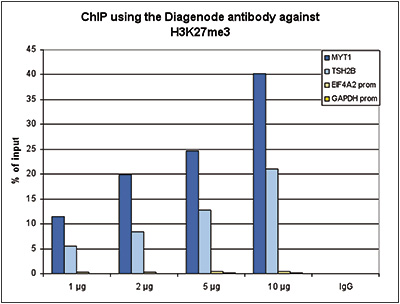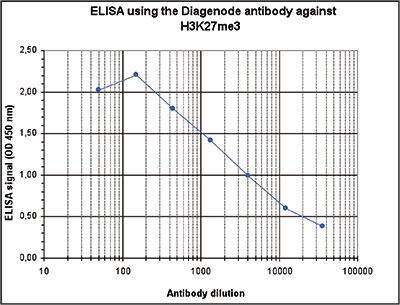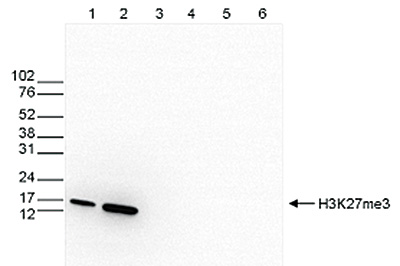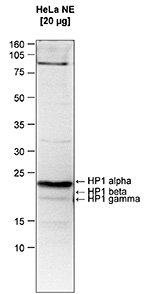 Figure 1. ChIP results obtained with the Diagenode antibody directed against H3K27me3
Figure 1. ChIP results obtained with the Diagenode antibody directed against H3K27me3 ChIP assays were performed using human HeLa cells, the Diagenode antibody against H3K27me3 (Cat. No. C15410069) and optimized PCR primer sets for qPCR. ChIP was performed with the “iDeal ChIP-seq” kit (Cat. No. C01010051), using sheared chromatin from 1 million cells. A titration of the antibody consisting of 1, 2, 5, and 10 μg per ChIP experiment was analysed. IgG (2 μg/IP) was used as negative IP control. QPCR was performed with primers for the promoters of the active genes EIF4A2 and GAPDH as negative controls, and for the coding regions of the inactive genes MYT1 and TSH2B as positive controls. Figure 1 shows the recovery, expressed as a % of input (the relative amount of immunoprecipitated DNA compared to input DNA after qPCR analysis). These results are in accordance with the observation that H3K27me3 is preferably present at inactive genes.
 Figure 2. ChIP-seq results obtained with the Diagenode antibody directed against H3K27me3
Figure 2. ChIP-seq results obtained with the Diagenode antibody directed against H3K27me3 ChIP was performed on sheared chromatin from 1 million HeLaS3 cells using 1 μg of the Diagenode antibody against H3K27me3 (Cat. No. C15410069) as described above. The IP’d DNA was subsequently analysed on an Illumina HiSeq. Library preparation, cluster generation and sequencing were performed according to the manufacturer’s instructions. The 51 bp tags were aligned to the human genome using the BWA algorithm. Figure 2 shows the enrichment in genomic regions of chromosome 6, surrounding the TSH2B gene (indicated by an arrow; fig 2A), of chromosome 20, surrounding the MYT1 gene (fig 2B), and of chromosome 2 and 3 (figure 2C and D).
 Figure 3. Determination of the antibody titer
Figure 3. Determination of the antibody titer To determine the titer of the antibody, an ELISA was performed using a serial dilution of the Diagenode antibody directed against H3K27me3 (Cat. No. C15410069). The antigen used was a peptide containing the histone modification of interest. By plotting the absorbance against the antibody dilution (Figure 3), the titer of the antibody was estimated to be 1:3,500.
 Figure 4. Cross reactivity test of the Diagenode antibody directed against H3K27me3
Figure 4. Cross reactivity test of the Diagenode antibody directed against H3K27me3 A Dot Blot analysis was performed to test the cross reactivity of the Diagenode antibody against H3K27me3 (Cat. No. C15410069) with peptides containing other modifications of histone H3 and H4 and the unmodified H3K27 sequence. One hundred to 0.2 pmol of the peptide containing the respective histone modification were spotted on a membrane. The antibody was used at a dilution of 1:5,000. Figure 4 shows a high specificity of the antibody for the modification of interest. Please note that that antibody also recognizes the modification if S28 is phosphorylated.
 Figure 5. Western blot analysis using the Diagenode antibody directed against H3K27me3
Figure 5. Western blot analysis using the Diagenode antibody directed against H3K27me3 Western blot was performed on whole cell (25 μg, lane 1) and histone extracts (15 μg, lane 2) from HeLa cells, and on 1 μg of recombinant histone H2A, H2B, H3 and H4 (lane 3, 4, 5 and 6, respectively) using the Diagenode antibody against H3K27me3 (Cat. No. C15410069) diluted 1:500 in TBS-Tween containing 5% skimmed milk. The position of the protein of interest is indicated on the right; the marker (in kDa) is shown on the left.
 Figure 6. Immunofluorescence using the Diagenode antibody directed against H3K27me3
Figure 6. Immunofluorescence using the Diagenode antibody directed against H3K27me3 Mouse NIH3T3 cells were stained with the Diagenode antibody against H3K27me3 (Cat. No. C15410069) and with DAPI. Cells were fixed with 4% formaldehyde for 10’ and blocked with PBS/TX-100 containing 5% normal goat serum and 1% BSA. The cells were immunofluorescently labelled with the H3K27me3 antibody (left) diluted 1:200 in blocking solution followed by an anti- rabbit antibody conjugated to Alexa488. The middle panel shows staining of the nuclei with DAPI. A merge of the two stainings is shown on the right.








